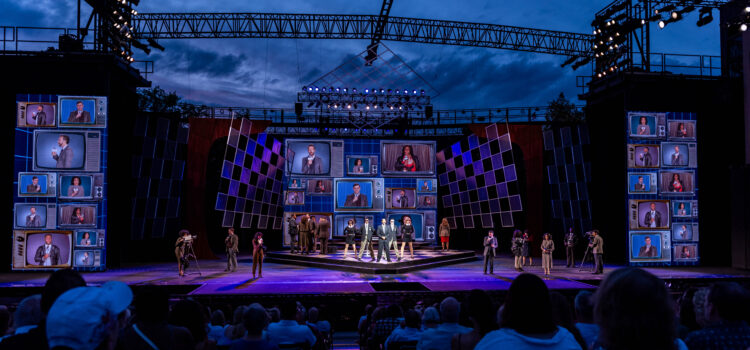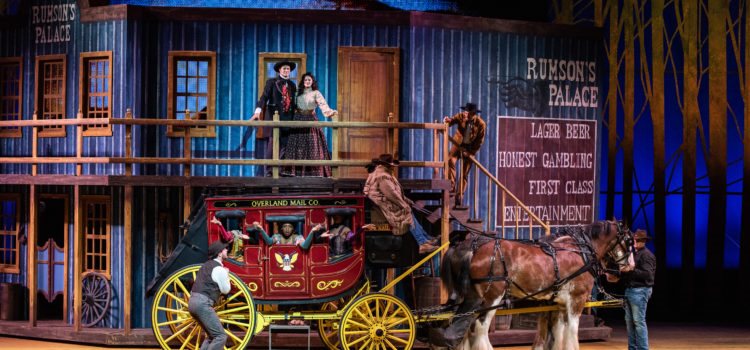By Lynn Venhaus
What was that?
A stunning showcase featuring some of the most passionate voices ever on a St. Louis stage, “Chess” is a love triangle, dramatic duel, a singular experience – and an extraordinary achievement for The Muny and its loyal audience.
For those not familiar with the show, either in concert or as musical theater, you are not alone. Those in-the-know cool kids had often waxed rhapsodic about the rock-symphonic score – and now we know why.
The 1986 rarely seen/performed pop opera, with music by Benny Andersson and Björn Ulvaeus of ABBA, and lyrics by Tim Rice (“Jesus Christ, Superstar” and “Evita”), concerns a clash of world powers at an international chess tournament.
Set during the highly charged ‘80s political atmosphere of the Cold War, the mind games between rivals Soviet Union and the United States escalate. Tensions are high, and so are the stakes. And then a fight develops over a woman that further complicates matters.
Most people know “Chess” only for its catchy pop hit, “One Night in Bangkok,” which was an MTV staple and now heard on classic radio stations (and fun fact, sung by Murray Head, the original Judas in “Jesus Christ Superstar.”) Its checkered history has become grist to the backstage mill, especially concerning the troubled book.
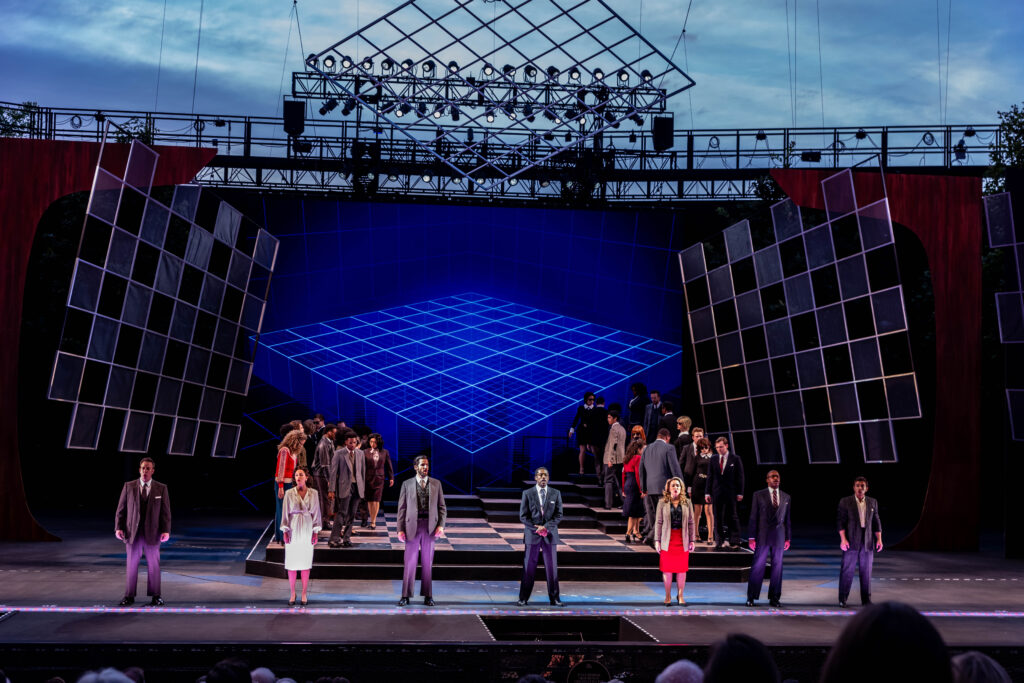
Initially a concept album in 1984, it opened as a theatrical piece in London two years later to much acclaim, and ran for three years. With an altered book, moved to Broadway in 1988, where it flopped (ran only for two months). A revival was staged in London’s West End in 2018, and now the Muny is doing what has been described as “mostly the London version” after other revisions over the years.
It is risky to bring something so different and uncommon to St. Louis audiences and mount it on the 102-foot-wide outdoor stage, where generations have delighted in the civic traditions and traditional productions for 105 years.
That, in itself, is a challenge, and the amount of care to create a compelling piece was evident in the collaboration between director and choreographer Josh Rhodes, music director Jason DeBord and the design dream team of Edward E. Haynes Jr. (scenic), Emily Rebholz (costumes), Rob Denton (lighting) and Alex Basco Koch (video).
Because this introduction was handled in such a spellbinding way, we all won. I still don’t know any more about chess than when I took my seat, but that’s OK. That’s not the point. And you don’t need to know anything either to marvel at the stylized look, the silky vocals, and the creative team’s bold choices.
This is not your mom’s “South Pacific” or even Andersson-Ulvaeus’ “Mamma Mia!” And from the reaction of the crowd, people were fine with that. The audience seemed genuinely excited to see something new to them, and they leaned in, responding with ovations that swelled more with each musical number.
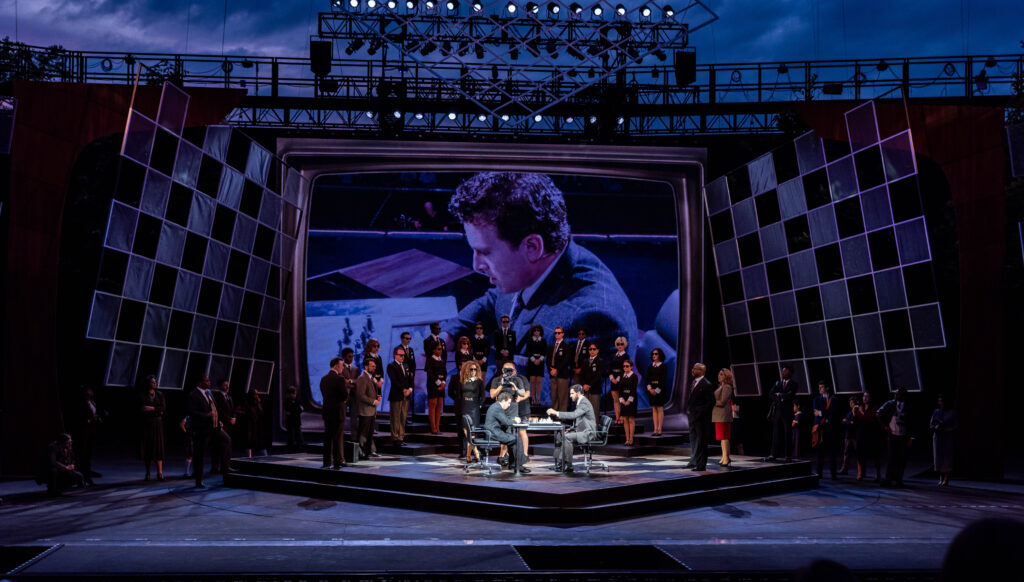
All around me, people were rapt – captivated by the political intrigue, the global playing field, the thorny romance – in other words, epic gamesmanship. When the boom opened to reveal an expansive, inventive set design, people applauded, and it grew from there.
The complex storyline isn’t the easiest to follow, and sometimes, the context is lost because of the ‘80s being the state of play. If you don’t understand the root of the hostilities, then it can appear to have a whiff of pretention.. (If you think about it, does mirror the decade!). It’s very helpful to read a synopsis ahead of time.
But what made this production something special were the leads – gifted with world-class talent, their powerful vocals soared into the night sky, and they hit the emotional beats to make the action matter.
John Riddle, a Muny veteran recently seen as Raoul in “The Phantom of the Opera” on Broadway, is sensational as the Russian grandmaster Anatoly Sergievsky. Among his many moments, he induced chills in the one-act finale solo, “Anthem,” giving his head vs. heart country dilemma depth.
When he falls in love with the Hungarian-born Florence, the remarkable Jessica Vosk reaches new heights. She wowed as Elphaba in “Wicked” on Broadway and as the Narrator in The Muny’s “Joseph and the Amazing Technicolor Dreamcoat” last year and has an exceptional voice.
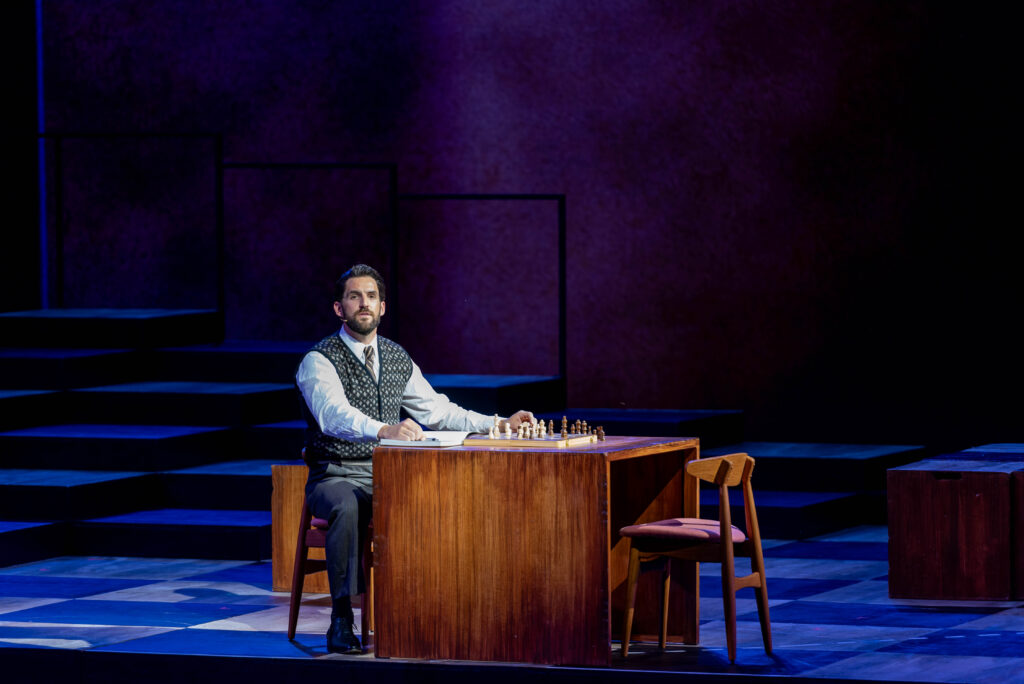
Their duet, “You and I” is simply gorgeous, and along with Jarrod Spector, as the flashy American grandmaster Frederick Trumper, their “Mountain Duet” is when the games really begin.
Vosk also wows in an intense “Nobody’s Side” with the ensemble, and in the conflicted “Heaven Help My Heart.”
In his second show this summer, Spector is quickly becoming a fan favorite. He was last seen in the season opener “Beautiful: The Carole King Musical” as Barry Mann, for which he was nominated for a Tony. He is well-cast as the brash, arrogant American whose cockiness and hot temper provoke controversy, and delivers a strong “One Night in Bangkok” ensemble number as well as his solo, “Pity the Child.”
Speaking of fan favorites, Tony nominee Taylor Louderman, who grew up in Bourbon, Mo., and has graced the Muny stage multiple times throughout her young life, isn’t seen until the second act. She plays the pivotal role of Anatoly’s wife, Svetlana, and history has its eyes on her. Looking fabulous in a beautiful white dress, she owns the stage in “Someone Else’s Story,” and is heartbreaking, along with Vosk, in “I Know Him So Well.”
Experienced Muny performer Phillip Johnson Richardson as The Arbiter (president of the International Chess Federation) is a formidable presence while Rodney Hicks, as Freddie’s financial administrator/secret CIA agent Walter De Courcey, and Tally Sessions, as part of Anatoly’s team and a KGB agent Alexander Molokov, stir up trouble and orchestrate double-crosses.
At Thursday night’s performance, unruffled associate music director Michael Horsley smoothly conducted the orchestra with a firm hand.
The design team’s concepts are striking, giving the show a certain look and attitude. Edward E. Haynes Jr., who won a St. Louis Theater Circle Award for his Gaslight Square inspired set of “Smokey Joe’s Café,” has created eye-catching geometric grids and continues a checkerboard theme throughout the pomp and circumstance of the European and Asian settings (Merano, Italy, and Bangkok, Thailand specifically).Video designer Alex Basco Koch’s work is integral here, with multimedia incorporated into the presentation.
With its dramatically operatic arc, moments of levity are few, but plunging back into ‘80s fashions is fun, especially spotting power suits and shoulder pads. Costume designer Emily Rebholz has made members of the ensemble look like they stepped out of Robert Palmer’s “Addicted to Love” music video, with their belted black mini dresses adorned with white collars.
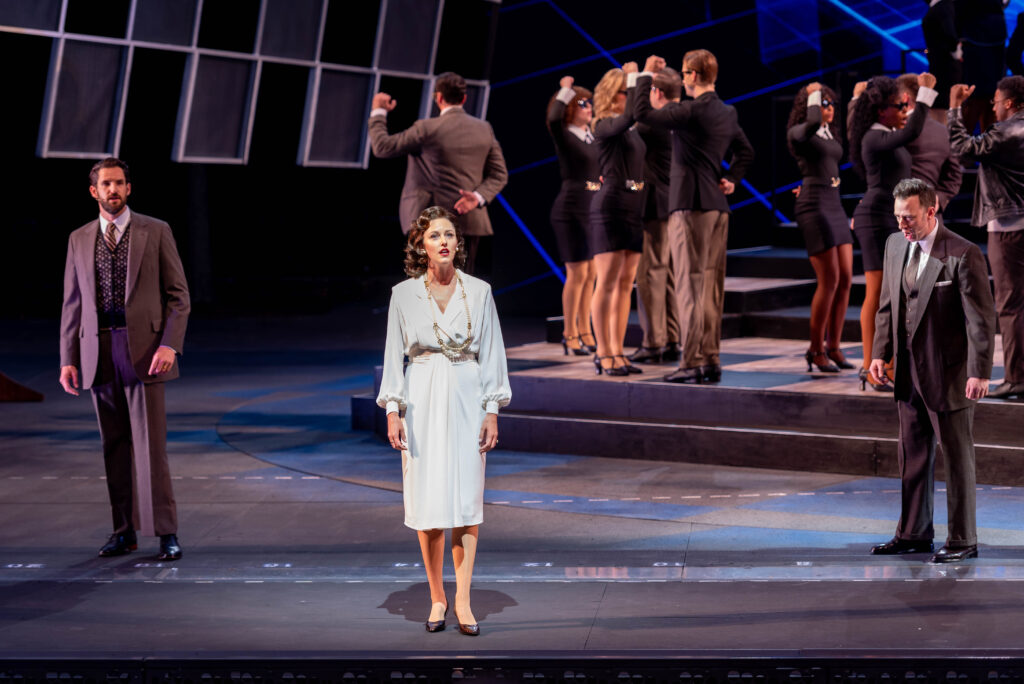
It was a smart move for The Muny to partner with the Saint Louis Chess Club and World Chess Hall of Fame for this presentation – after all, St. Louis was the site of the first official world championship in 1886 and home to many devotees. (Stop by their Central West End location for free exhibits and tours).
Although the characters are fictional, supposedly the American is loosely based on champ Bobby Fischer while the Russian is a composite of Viktor Korchnoi and Anatoly Karnov. Book writer and lyricist Tim Rice had a Cold War musical for awhile on his radar, fascinated by the 1972 “Match of the Century” between Fischer and Boris Spassky, and that adds context too.
For those who remember the Cold War, “Chess” taps into the two world powers trying to manipulate to gain the upper hand, and in the Reagan years, when the U.S.’s strong anti-communist agenda swelled after the Iran Hostage Crisis and other international trouble spots.
Sixty years after I learned to ‘duck and cover’ during the Cuban Missile Crisis, Russia is a constant thorn in the U.S. side and is at war with Ukraine. The more things change, the more they remain the same.
As a commentary on strategizing geopolitics and propaganda, “Chess” is interesting, but as a bittersweet love story, has more emotional heft. Already in the record books as the largest production of a “Chess” revival, the chief pleasure in The Muny’s grand, inspired staging is the powerhouse vocals.
In sports terms that we can all identify with, The Muny knocked it out of the park, giving us a dandy night to remember.
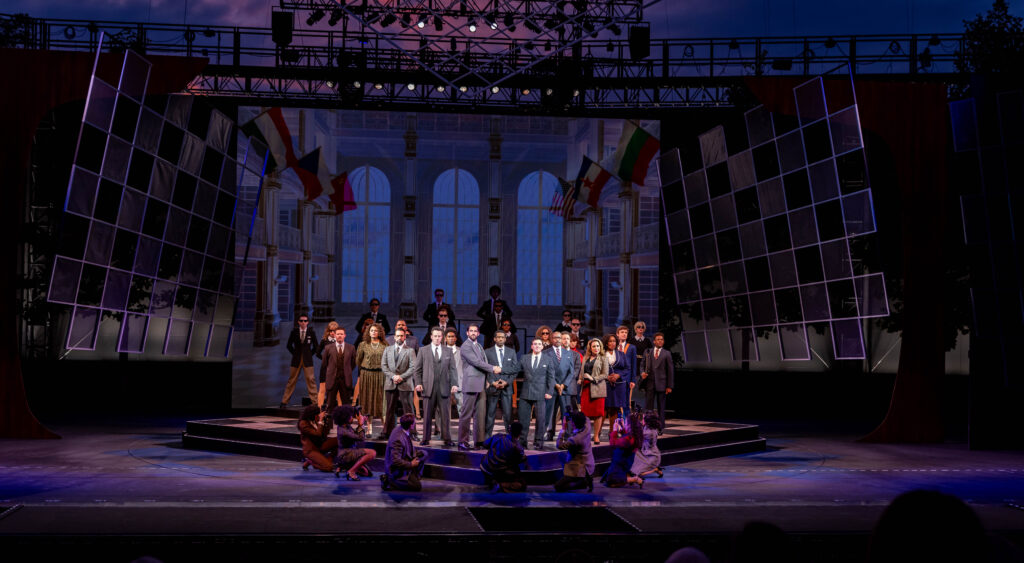
The Muny presents the musical “Chess” July 5-11 at 8:15 p.m. on the outdoor stage in Forest Park. For more information: muny.org.
Photos by Phillip Hamer


Lynn (Zipfel) Venhaus has had a continuous byline in St. Louis metro region publications since 1978. She writes features and news for Belleville News-Democrat and contributes to St. Louis magazine and other publications.
She is a Rotten Tomatoes-approved film critic, currently reviews films for Webster-Kirkwood Times and KTRS Radio, covers entertainment for PopLifeSTL.com and co-hosts podcast PopLifeSTL.com…Presents.
She is a member of Critics Choice Association, where she serves on the women’s and marketing committees; Alliance of Women Film Journalists; and on the board of the St. Louis Film Critics Association. She is a founding and board member of the St. Louis Theater Circle.
She is retired from teaching journalism/media as an adjunct college instructor.

